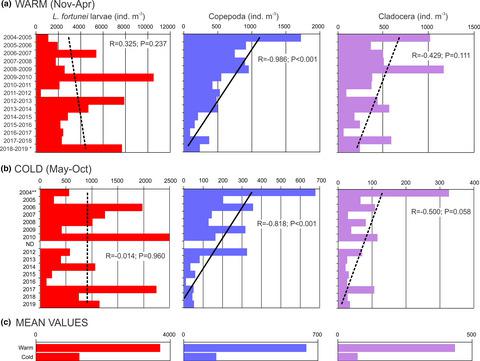当前位置:
X-MOL 学术
›
Austral Ecol.
›
论文详情
Our official English website, www.x-mol.net, welcomes your
feedback! (Note: you will need to create a separate account there.)
Multiannual trends (2004–2019) in the abundance of larvae of the invasive mussel Limnoperna fortunei and crustacean zooplankton in a large South American reservoir
Austral Ecology ( IF 1.6 ) Pub Date : 2021-05-20 , DOI: 10.1111/aec.13058 Demetrio Boltovskoy 1 , Facundo Bordet 2 , Valentín Leites 2 , Daniel Cataldo 1
Austral Ecology ( IF 1.6 ) Pub Date : 2021-05-20 , DOI: 10.1111/aec.13058 Demetrio Boltovskoy 1 , Facundo Bordet 2 , Valentín Leites 2 , Daniel Cataldo 1
Affiliation

|
The behavior of non-indigenous species with time since introduction varies widely and is a major issue in the understanding of their long-term effects on the habitats colonised. We analysed the long-term trends in the densities of larvae of the invasive mussel Limnoperna fortunei and planktonic Copepoda and Cladocera in Salto Grande, a large South American reservoir in the Uruguay River (Argentina-Uruguay), on the basis of weekly samples collected between June 2004 and November 2019. All three groups depicted variable interannual abundances. While mussel veligers showed no significant interannual trends (overall mean: 2552 larvae L−1), crustaceans decreased significantly in the time elapsed (Copepoda: from ˜1000 to 100 ind. L−1; Cladocera: from ˜500 to 100 ind. L−1). We conclude that increasing discharge rates by the Uruguay River and the concomitant decreases in reservoir water residence times are the most likely cause for these drops in their populations. As opposed to many other invasive species elsewhere, and to the same mussel in other South American waterbodies, L. fortunei larvae did not change in abundance with time since introduction. Our results underscore the assumption that each biological introduction is a particular and highly context-dependent event and the dynamics of biological invasions in general elude broad generalizations.
中文翻译:

南美大型水库中侵入性贻贝 Limnoperna Fortunei 和甲壳类浮游动物幼虫丰度的多年趋势(2004-2019)
自引入以来,非本土物种的行为随时间变化很大,这是了解它们对殖民栖息地的长期影响的一个主要问题。我们分析了乌拉圭河(阿根廷-乌拉圭)南美大型水库萨尔托格兰德的入侵贻贝Limnoperna Fortunei和浮游桡足类和枝角类的幼虫密度的长期趋势,基于每周收集的样本2004 年 6 月和 2019 年 11 月。所有三个组都描述了年际丰度的变化。虽然贻贝 veligers 没有显着的年际趋势(总体平均值:2552 只幼虫 L -1),但甲壳类动物在经过一段时间后显着减少(桡足类:从 ~1000 到 100 ind. L -1; 枝角类:约 500 至 100 英寸。L -1 )。我们得出的结论是,乌拉圭河的排放量增加以及水库水停留时间随之减少是导致其种群数量下降的最可能原因。与其他地方的许多其他入侵物种以及其他南美水体中的同一贻贝相比,L . 自从引入以来,fortunei幼虫并没有随着时间的推移而大量变化。我们的结果强调了这样一个假设,即每个生物引入都是一个特定的且高度依赖于上下文的事件,并且生物入侵的动态通常无法进行广泛的概括。
更新日期:2021-05-20
中文翻译:

南美大型水库中侵入性贻贝 Limnoperna Fortunei 和甲壳类浮游动物幼虫丰度的多年趋势(2004-2019)
自引入以来,非本土物种的行为随时间变化很大,这是了解它们对殖民栖息地的长期影响的一个主要问题。我们分析了乌拉圭河(阿根廷-乌拉圭)南美大型水库萨尔托格兰德的入侵贻贝Limnoperna Fortunei和浮游桡足类和枝角类的幼虫密度的长期趋势,基于每周收集的样本2004 年 6 月和 2019 年 11 月。所有三个组都描述了年际丰度的变化。虽然贻贝 veligers 没有显着的年际趋势(总体平均值:2552 只幼虫 L -1),但甲壳类动物在经过一段时间后显着减少(桡足类:从 ~1000 到 100 ind. L -1; 枝角类:约 500 至 100 英寸。L -1 )。我们得出的结论是,乌拉圭河的排放量增加以及水库水停留时间随之减少是导致其种群数量下降的最可能原因。与其他地方的许多其他入侵物种以及其他南美水体中的同一贻贝相比,L . 自从引入以来,fortunei幼虫并没有随着时间的推移而大量变化。我们的结果强调了这样一个假设,即每个生物引入都是一个特定的且高度依赖于上下文的事件,并且生物入侵的动态通常无法进行广泛的概括。











































 京公网安备 11010802027423号
京公网安备 11010802027423号